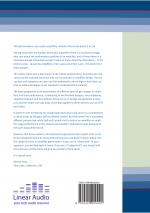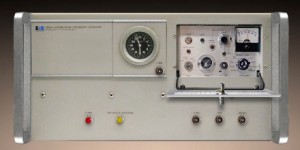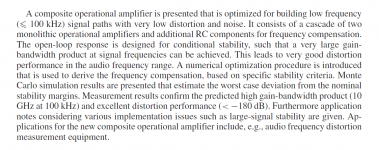John,A really interesting book that I have been going through is: 'Analog IC design: the current mode approach' that goes back to 1990. Although most of the exotic topologies are not made for audio, they are interesting, nevertheless. .
I am all settled in Bangkok for the duration. I found the most important book ever written lately to be from Linear Audio NL publications. If you are looking for SOTA designs, forget Cordell, Self and Wurcer.
Study "Audio Power Amplifiers - Towards inherently linear amplifiers" by Arto Kolinummi
Linear Audio | your tech audio resource
-Richard
Last edited:
You can make your own for maybe $30 and most of that is in the meters. I'm sure I've seen an Arduino project on Hackaday to do that.I hear you John, I would love to see some new topologies to learn about..I am afraid a lot of audiophoolery is instead going toward stuff like this:
McIntosh MCLK12 McIntosh Meter Clock | Audio Advice
Geesh, I wish I had the kind of money that would make buying this seem rational...
Howie
Take your pick, many of these have seconds meters! McIntosh decal sold (or pirated) separately.
Arduino analog clock meter project - Google Search
Here's Nelson's blurb from the back cover:John,
I am all settled in Bangkok for the duration. I found the most important book ever written lately to be from Linear Audio NL publications. If you are looking for SOTA designs, forget Cordell, Self and Wurcer.
Study "Audio Power Amplifiers - Towards inherently linear amplifiers" by Arto Kolinummi
Linear Audio | your tech audio resource
-Richard

And here's the Table of Contents:
View attachment ak toc web.pdf
Cheers,
Jeff
Last edited:
Demian: dunno why but I'd get the 5071A, mainly as they couldn't decide on LED or LCD displays so gave it both 🙂
Just look inside a Parasound amplifier, preamplifier, etc, and you will find internal connectors of marginal construction. They are sold today, as were similar models that were made 20years ago, and still discussed here. It is almost impossible to make a REPAIRABLE design without internal connectors. Yes, I am a grandpa, and hope, before I go, to be a great-grandpa!
So... I don't even use a preamplifier. How an old piece of equipment might look inside is completely unimportant as I see it. Preamplifiers do not have a part in a modern high end system. Your repetitive wining about how it things was for 20 or 40 years ago is just an obstruction to me when I'm looking for relevant up-to-date information about audio technology. So why am I here - because this happens to be the thread on DIYAUDIO that contain the most interesting and knowledgable persons sharing the most interesting ideas and thoughts - and I keep visiting it despite that I have to pass some of your posts now and then - it's still worth that inconvenience.
//
... I am still solving problems, the latest being how to combine the best of jfets and tubes to make a really nice 'hybrid' line amp. It is not as easy as it might appear...
John, a single triode will give you more than -80dB noise and/or distortion, with just a bit of care, and no GFB. Adding a JFET may get you down to -100dB, or are you targeting the "digital" spec's of -120dB?
Hi Zung. What we need is a super high quality solid state unity gain inverter in front of two open loop triodes. That is the challenge.
John, check out Samuel Groner's article in the Journal of the AES, Vol 65, No 5 (May 2017). He shows a solid state unity gain inverter with exceptional measured performance. Jan Didden has laid out a PCB which implements Groner's design, and Jan has verified the performance claims. I was able to hoodwink Jan into sending me 3 of his PCBs. They are wonderful.
Groner's abstract is attached below.
_
Groner's abstract is attached below.
_
Attachments
They are wonderful. Groner's abstract is attached below.
Last sentence stated its potential app as measurement device. JC is sure interested with audio amplifier. I couldn't see how the super wide bandwidth (and even the too good THD) has something new to offer for audio. They are wonderful, yes, but how about a pre amplifier using that? Will it sound better than the old OP627+OPA603 composite? Or will they equally be worse than discrete options?
Demian: dunno why but I'd get the 5071A, mainly as they couldn't decide on LED or LCD displays so gave it both 🙂
Sorry, but I trust the Patek Philippe clock in the middle more than the rest of it to keep time. . .
There was conjecture that the clock was a bit of a inside joke and probably worth more to collectors than the rest of the instrument.
Thanks Mark, but this goes in the wrong direction. Audio 'quality' usually does not necessarily mean unmeasurable distortion due to extreme amounts of negative feedback and feedforward. This can be very necessary and helpful for some industrial tasks. No, I am looking at an open-loop approach if possible or perhaps using a 'long tailed pair' triode stage.
"Condemnation without Examination is Prejudice"
I agree there are a lot of potential issues with the design but its not hard to explore and may be worthwhile. I would not condemn without giving it a listen. Possibly using different opamps to address input current etc.
I agree there are a lot of potential issues with the design but its not hard to explore and may be worthwhile. I would not condemn without giving it a listen. Possibly using different opamps to address input current etc.
Demian, I would doubt it. You, I and many others know how to design low (enough) distortion circuits. I, and I am not the only one, or even the first one, to realize that negative feedback seems to cause as many problems as it solves.
For example, back in the early 1980's, I was commissioned by Sound Technology to make a similar gain stage with discrete devices. The most important challenge was very low distortion at 100KHz. This is where the IC's of the time, even the Harris devices often used then, would fail. I designed the most linear circuit that I could, ran it class A of course, and then used multi-pole compensation to achieve a 100KHz open loop bandwidth. Still, I would never use this design for audio. It is too complex. Most IC's are even more complex and that is a problem for audio in my experience.
For example, back in the early 1980's, I was commissioned by Sound Technology to make a similar gain stage with discrete devices. The most important challenge was very low distortion at 100KHz. This is where the IC's of the time, even the Harris devices often used then, would fail. I designed the most linear circuit that I could, ran it class A of course, and then used multi-pole compensation to achieve a 100KHz open loop bandwidth. Still, I would never use this design for audio. It is too complex. Most IC's are even more complex and that is a problem for audio in my experience.
Or operate the triode common grid by feeding the cathode from a jfet buffer. 🙂... or perhaps using a 'long tailed pair' triode stage.
So... I don't even use a preamplifier. How an old piece of equipment might look inside is completely unimportant as I see it. Preamplifiers do not have a part in a modern high end system.
//
Hi TNT, I understand your point, and yes, SOTA DACs are very good and make the volume control job. Still, there is a weak point. The weakest point of SOTA DACs is a digital volume control. With a power amplifier of standard gain like 27dB, you usually have to use DAC (preamp) volume set at -40dBFS to -20dBFS for normal listening level. In the same way, you worsen S/N ratio and useful dynamic range, because noise level at the DAC output remains the same. You are able to design a preamp with much lower noise than any DAC analog output has, -120dBV(A) is not difficult to get with a good preamp. You let the DAC work at FS and make analog attenuation, instead of digital. And you get better results, measurable results, and to me, better sonic result. So, IMO, preamp is still an important part of the audio chain.
The question is our goal, which may be individual. I suspect that the request for "high sound quality" represented by open loop designs+triodes e.g. is nothing else than asking for a different sound, signal modification, which does not represent the exact amplified copy of the input signal. I am also afraid that those who keep this path do not realize that they in fact call for signal modification, not for a true signal amplification.
What's wrong with passive attenuation? Surely the DAC's output impedance and amplifier's input impedance are suitable most of the time with a short cable run?
That is true to some extent, but there are a number of commercial DACs that have analog volume control, even ladder attenuators. I don't think the loss of SNR/DNR is a concern in the highest end devices when we have ICs that hit 130 dB DNR and perform best in terms of distortion below FS anyway.Hi TNT, I understand your point, and yes, SOTA DACs are very good and make the volume control job. <snip>
It takes some work or extra complexity to not degrade the distortion or noise performance of a DAC like the ES9038 or AK4499 with an analog attenuator. There are LOTS of preamps that measure worse than these DACs.
What's wrong with passive attenuation? Surely the DAC's output impedance and amplifier's input impedance are suitable most of the time with a short cable run?
Nothing if it is low impedance and does not add thermal noise and if the preceding stage is able to drive low impedance. It may be a good solution but less universal.
Yes but I have comparisons (measured) between good DACs with digital volume control and same DACs with analog preamp added. I have always measured lower noise and lower SINAD (reversed THD+N) with DAC operated near FS and analog preamp.It takes some work or extra complexity to not degrade the distortion or noise performance of a DAC like the ES9038 or AK4499 with an analog attenuator. There are LOTS of preamps that measure worse than these DACs.
- Status
- Not open for further replies.
- Home
- Member Areas
- The Lounge
- John Curl's Blowtorch preamplifier part III

